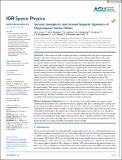Auroral, ionospheric and ground magnetic signatures of magnetopause surface modes
Abstract
Surface waves on Earth's magnetopause have a controlling effect upon global magnetospheric dynamics. Since spacecraft provide sparse in situ observation points, remote sensing these modes using ground-based instruments in the polar regions is desirable. However, many open conceptual questions on the expected signatures remain. Therefore, we provide predictions of key qualitative features expected in auroral, ionospheric, and ground magnetic observations through both magnetohydrodynamic theory and a global coupled magnetosphere-ionosphere simulation of a magnetopause surface eigenmode. These show monochromatic oscillatory field-aligned currents, due to both the surface mode and its non-resonant Alfvén coupling, are present throughout the magnetosphere. The currents peak in amplitude at the equatorward edge of the magnetopause boundary layer, not the open-closed boundary as previously thought. They also exhibit slow poleward phase motion rather than being purely evanescent. We suggest the upward field-aligned current perturbations may result in periodic auroral brightenings. In the ionosphere, convection vortices circulate the poleward moving field-aligned current structures. Finally, surface mode signals are predicted in the ground magnetic field, with ionospheric Hall currents rotating perturbations by approximately (but not exactly) 90° compared to the magnetosphere. Thus typical dayside magnetopause surface modes should be strongest in the East-West ground magnetic field component. Overall, all ground-based signatures of the magnetopause surface mode are predicted to have the same frequency across L-shells, amplitudes that maximise near the magnetopause's equatorward edge, and larger latitudinal scales than for field line resonance. Implications in terms of ionospheric Joule heating and geomagnetically induced currents are discussed.
Citation
Archer , M O , Hartinger , M D , Rastätter , L , Southwood , D J , Heyns , M , Eggington , J W B , Wright , A N , Plaschke , F & Shi , X 2023 , ' Auroral, ionospheric and ground magnetic signatures of magnetopause surface modes ' , Journal of Geophysical Research: Space Physics , vol. 128 , no. 3 , e2022JA031081 . https://doi.org/10.1029/2022JA031081
Publication
Journal of Geophysical Research: Space Physics
Status
Peer reviewed
ISSN
2169-9380Type
Journal article
Description
Funding: MOA holds a UKRI (STFC /EPSRC) Stephen Hawking Fellowship EP/T01735X/1. MDH was supported by NASA grant 80NSSC19K0907 and NSF grant AGS 2027210. DJS was supported by STFC grant ST/S000364/1. MH was supported by NERC grant NE/V003070/1 and Schmidt Science Fellows, in partnership with the Rhodes Trust. JWBE was supported by NERC grants NE/P017142/1 and NE/V003070/1. A.N.W. was partially funded by STFC grant ST/N000609/1. XS is supported by NASA award 80NSSC21K1677 and NSF award AGS-1935110.Collections
Items in the St Andrews Research Repository are protected by copyright, with all rights reserved, unless otherwise indicated.

